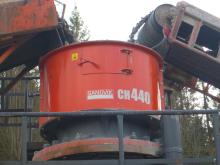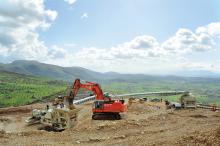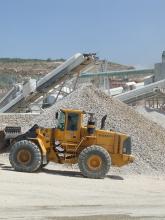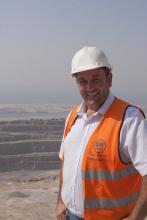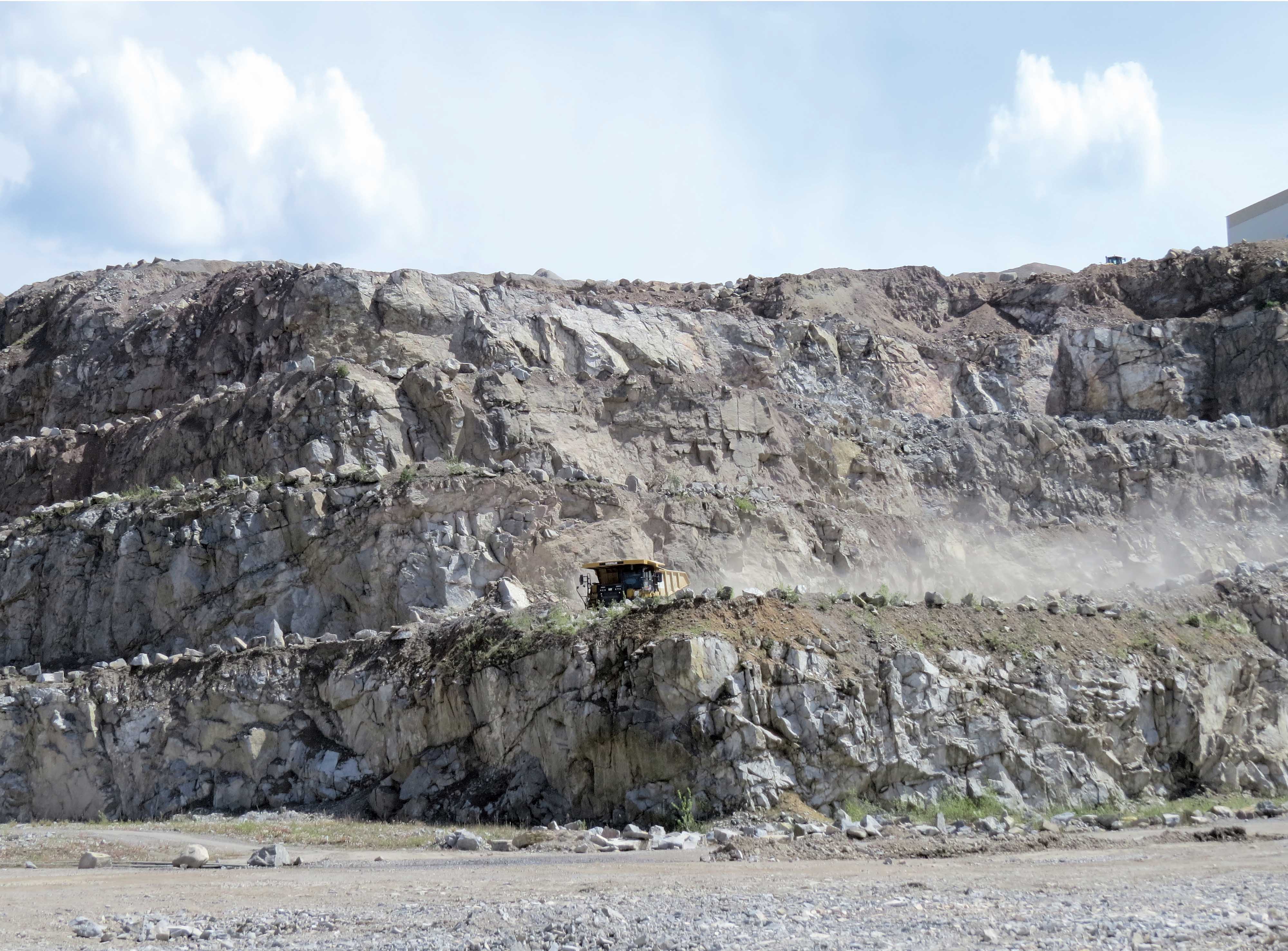
Fuel efficiency along with higher productivity are the aims of a major German quarry that produces granite material for a variety of uses. The company took a look at its operations and decided to ask German Caterpillar dealer Zeppelin to help achieve its aims using the latest technology, including Cat VisionLink that allows quarry operators to quickly and easily view all their equipment in a secure web-based application hosted by
“When you consider that around 30% of running a quarry is taken up by fuel costs then it makes sense to try to make sure the whole operation is running as efficiently as possible,” says Jorg Schwinger, managing director.
Parameters are set by the company as part of its plan to meet fuel efficiency and productivity targets.
The Karl Schwinger quarry at Nittenau, near Regensburg, 150km north of Munich in southern Germany, was started in 1880, but at that time it did not belong to Schwinger family, who bought the site in 1974.
However, the family did at one time own a number of quarries north of the current site, including one at Rossbach.
“My grandfather helped to build the railway to the old quarry at Rossbach but after nearly 100 years it stopped,” says Jorg Schwinger.
Covering some 25 hectares, with a further 25 hectares available, the Regensburg quarry has enough reserves for another 50 years, and its average weekly production is between 20,000 -22,000 tonnes. Its annual production averages some 1 million tonnes.
Blasting is carried out on average two or three times each month and each blast produces between 50,000 – 60,000tonnes of raw material, which in this case is granite and diorite that has a variety of uses.
The blast simulation and programming of blast is done by Schwinger, and the drilling is done by a contractor using an
Much of the loading and hauling at the quarry is carried out using Caterpillar equipment supplied through Zeppelin, while various machines are used for crushing and screening, including
At the time of my visit the quarry was operating two shifts totalling 16 hours/day, Monday to Saturday.
The company’s key markets are mainly southern Germany along with the bordering countries of Austria and Switzerland, and its main segment is asphalt industry, with Schwinger specialising in low emission asphalt (porous asphalt).
However, the company also produces materials for concrete production; railway ballast for the federal railway and high-speed railway networks; frost protection gravel for civil engineering projects; bulk materials for industrial buildings, and gabions filled with granite stones for gardens.
“We also specialise in producing very big stones for water infrastructure. Big river stones are used in the northern Alps and Germany. River stones can be as big as 3m long, and are taken straight after blasting,” says Jorg Schwinger, whose company can list many prestigious projects for which it has supplied materials.
Following blasting at the quarry any large rocks are reduced in size as a 6.5tonne steel ball is dropped on them, and then the material is loaded onto a Cat 775G or Cat 775F dump truck for hauling (depending on the production situation the company runs one truck or both). Loading is carried out using a Cat 385C FS hydraulic excavator with a 5m³ bucket or a Cat 374D hydraulic excavator with 4.6m³bucket.
Typically Schwinger uses the Cat 385C FS for material extraction but depending on blast quality the company sometimes uses the Cat 374D.
Material is transported from the deep quarry up a haul road to the primary crusher, a Weserhütte double-toggle jaw crusher with an hourly production capacity of 350-400tonnes. The crusher was built in Germany in 1980 and was supplied with all the spare parts.
The first stage sees the rocks reduced to 250mm before being moved by conveyer belt to the secondary crusher, a Sandvik CH660 cone crusher, which runs at an hourly production capacity of 350tonnes, depending on production requirements. It has been joined by a Sandvik S400 horizontal impact crusher.
“What we focus on here is railway ballast. We want to have about 350tonnes/hour,” says Jorg Schwinger.
Three tertiary Svedala (Sandvik) cone crushers, a H2000; Svedala 3000 and a Svedala H 4-36, are housed in a large covered facility.
After screening, gravels from 22mm down to sand are produced, and these are used mainly for the asphalt industry.
“We also specialise in low emission asphalt. We supply various companies with material,” says Jorg Schwinger.
“There are only a few companies that produce this kind of material. It takes a lot of experience and also the basic material has to be very high quality.”
The company is also one of the biggest producers in Bavaria of railway ballast, and material is moved out by road and train, with the company loading one big train with about 1,200tonnes of products each working day between February and November/December. With a connection near the quarry, deliveries are mainly in the south of Germany with train, owned and operated by DB Schenker, covering up to 300km.
Drilling
1 x Atlas Copco ROC D7
Loading
1 x Caterpillar 972H wheeled loader
1 x Caterpillar 972K wheeled loader
2 x ITG14 wheeled loaders
1 x Caterpillar 385C FS front shovel excavator
1 x Caterpillar 374D backhoe excavator
1 x Caterpillar 345DL backhoe excavator
1 x Caterpillar 322D backhoe excavator
Hauling
1 x Caterpillar 775F dump truck
1 x Caterpillar 775G dump truck
Primary crushing
1 x Weserhütte primary jaw crusher
Secondary crushing
1 x Sandvik CH660 cone crusher
1 x Sandvik S400 horizontal impact crusher
Tertiary crushing
1 x Svedala (Sandvik) H2000 cone crusher
1 x Svedala (Sandvik) 3000 cone crusher
1 x Svedala (Sandvik) H 4-36 cone crusher
Mobile crushing
1 x Metso Lokotrack LT110 jaw crusher
1 x Metso Lokotrack LT1200 cone crusher
Loading operations are carried out by a Cat 972H wheeled loader and a Cat 972K wheeled loader using the CPM (Cat 972K) and PCS (Cat 972H) on-board weighing systems.
Annual usage of the each machine in company’s fleet is approximately 2,000-2,200 hours, while with the Cat 775F there is a replacement target of 16,000 hours, and for the Cat 972K and Cat 972H there is a target of getting them replaced after 10,000 hours (Schwinger has a Zeppelin Buy Back Guarantee).
For the Cat 385C FS the plan is to get a Cat Certified Rebuild, and the company was looking at buying a Cat 972M XE for lower fuel consumption.
Schwinger says that its objectives are to lower the cost per tonne and reduce fleet fuel consumption fleet by using- established metrics and by the monitoring of four key metrics.
In material extraction, the company looks at the actual percentage compared to the target, which is a daily production of 4,000tonnes in an 11-12 hour/day.
Over-production can be stored in a buffer near the primary crusher, and this metric looks at actual stock in silo versus the target in percentage terms while utilisation of crushers looks at crusher run time against total possible run time.
For example, if a crusher achieves run time of 12 hours in a 16 hour shift, crusher utilisation would be 75%.
A metric also looks at utilisation of the mobile equipment (idling ratio percentage) of the fleet by the tracking of idling time against total run time. Again as an example if the Cat 775G has working time of 12 hours and idling time of four hours in a 16-hour shift, equipment utilisation would be at 75%.
With VisionLink used for all monitoring, weekly reports of the four key metrics are produced with current targets based on actual results from previous years. If weekly targets are achieved, the team gets a family meal as an incentive.
Schwinger says that since it started monitoring through VisionLink, the efficiency of all four measured metrics has significantly improved with a reduction in idling time, with monitoring and operator training helping to achieve this along with a significant reduction in fuel consumption. The Cat 775G is also said to have a significantly lower fuel consumption than Cat 775F.
“Every year we face a new average, and every year it is going up,” says Jorg Schwinger.
As the operators play a key role in productivity and efficiency, refresher training is given six by Zeppelin operator trainers.
Schwinger says that as machine uptime and availability are critical for the quarry operation, efficient dealer service is needed, and as the nearest Zeppelin branch is in Straubing, 35km from the quarry, it is “very satisfied” with the Zeppelin service, with all its Cat equipment having Cat customer support agreements (CSA).
Also in operation at the quarry are two mobile crushers, a Metso Lokotrack LT1100 jaw crusher and a secondary crusher, a Metso LT1200 cone crusher, powered by CAT C13 engines. Here a Caterpillar 345DL excavator is used for loading purposes.
Both machines work in the highest part of the quarry, producing 0-32mm materials for the anti-freeze layers in roads.


